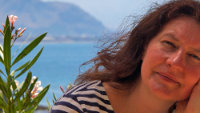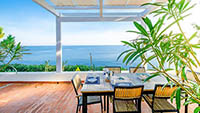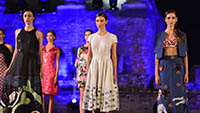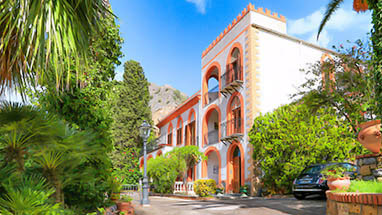Cefalu: A beach holiday by a Norman cathedral and stunning mountains

If you can't decide between the beach or the mountains for your holiday in Sicily, Cefalù is the perfect place to base yourself. Things to do in Cefalù include relaxing on the long, sandy beach and cooling down in the sea; visiting the stunning cathedral with its real gold mosaics; and climbing the mountains it nestles in, which form part of the "Madonie" nature reserve.
Cefalu's rocky outcrop looking out over the Mediterranean, and the extensive beach down below, first attracted Sicily's Norman invaders to found the city here 800 years ago. The town runs from the craggy mountains right down to the sea. Much of it – most notably the famous cathedral – still has an atmospheric medieval look which makes Cefalù the highlight of many people's holidays in Sicily. The town is small enough to explore fully on foot, and the absence of traffic is one of the many characteristics that make it such a great place for visitors.
This is why many holiday-makers in Sicily base themseves in Cefalù. The website Destination Cefalù offers plenty of information on things to do in Cefalù – follow the link Perfect beaches and a stunning cathedral.
Author

The information on this site comes from our Sicily expert Britta Bohn.
Britta has been dealing with daily life and life in Sicily for over 20 years.
Don't miss any of her tips! Subscribe to our free Newsletter:
An Invitation
Dear friends of Sicily, we invite you to join the Facebook Group "Trip-Tipp Sicily". Find answers to all your questions and discover exclusive tips for your trip to Sicily from those who have already made the journey and those who already know the island from the inside out:
Content
- Map - Sightseeing Tour of Cefalu
- Cefalù - Impressions of the town
- Bird's-Eye View from the Rocca over the Roofs of Cefalù
- A virtual walk through the Cathedral
- Find your ideal Holiday Letting
Holidays lettings in Sicily

Are you looking for holiday lettings in Sicily but can't see the wood for the trees? We're not surprised, because the range of choices competing online is pretty confusing.
To make it simple, we present a small selection of quality holiday rentals, each one chosen for an unusual feature to make your holiday in Sicily extra special... more
Fashion made in Sicily

Sicilian fashion? Dolce & Gabbana?
Sure! But fashion designed and manufactured in Sicily is the real insider tip.
Like that of the Sicilian designer Filly Cusenza from Bagheria. She creates wearable art made of fabric, thread and buttons. Her trademark and label name is the fancy cartoon girl Filly Biz... more
The Essence of Sicily

Sightseeing Tour of Cefalu

- From the motorway exit to the car park
- From the car park to the motorway exit
- From the station to Corso Ruggero
- Sea front
- Osterio Magno
- Cathedral
- Bastione di Capo Marchiafava
- Museo Mandralisca
- Lavatoio Medievale (medieval river laundry)
- Old harbour (Porto Vecchio)
- Marina (Porto Turistico)
Reaching Cefalù by car

Cefalu is located close to the A20 motorway. The blue line at the top of the map shows the route from the motorway exit to a large car park next to the beach (marker 2). You can park your car here all day for a few euros.
The red line shows the slightly differing way back. As the largely straight lines show, Cefalu beach is easy to reach even if the Sicilians make you a nervous driver!
There is more information on touring Sicily by car on the Car Hire page.
Reaching Cefalu by Train (Trenitalia)

If you don't want to use a rental car, Cefalù is still very easy to reach by Train, and an ideal starting point from which to explore Sicily.
The train from Palermo to Cefalu takes less than an hour. The journey from Messina to Cefalu takes 2 to 3 hours depending which connection you use.
As the map above shows, Cefalu station is near the centre of town (marker 1). The beach and the historic town centre are just a few hundred metres away.
Holidays in Cefalu

There is a great variety of hotels, apartments and other types of holiday accommodation in Cefalù. The historic Villa Caterina (pictured right) stands out among them.
It contains six separate holiday apartments and a very large Mediterranean garden. Every holiday flat has its own private terrace as well. There are guest parking spaces in the large courtyard.
Villa Caterina is just a few hundred metres from the beach, the town centre and the railway station.
Cefalù - Impressions of the town

The Beach
 Pin it
Pin it One of the most obvious things to do in Cefalù is relax or play on the beach which borders its northern and western side. It is one kilometre of the softest, finest sand in the Mediterranean flanked by an exciting stretch of coffee bars and restaurants which serve a huge variety of meals, drinks, ice creams and some really traditional Sicilian classics to suit every budget.
If you're not staying in Cefalù, it is always easy to park for the day in the large, supervised car park opposite the beach (marker 2). The Trenitalia railway station is also nearby (marker 1).
Like all beaches, Cefalù beach gets pretty full in summer. It's a different story outside the July-August high season, when large stretches of sand may be almost empty.
In April the Mediterranean sea around Sicily is not very warm. In autumn, from September to late October, Cefalù beach is just as empty but the water is still beautifully warm from the summer sun. If you don't want to swim, a stroll along the beach in winter can be pure relaxation.
- TripAdvisor reviews of the beach of Cefalu.
Bird's-Eye View from the Rocca over the Roofs of Cefalù
How to virtually enjoy the view from the Rocca:
- click or tap the green circle in the middle of the image to start the tour
- drag your finger or mouse left, right, up or down to change the camera angle; you can also use the arrow keys on your keyboard

Rocca
 Pin it
Pin it There are many places in Sicily where you can be by the mountains and the sea both at once, which means you have plenty of both relaxing and exciting things to do on holiday. Cefalù is defined by this idyllic setting. Whichever part of town you are in, the eastern skyline is dominated by the looming cliffs and mountains of the Rocca. To the west, you'll see the clear blue sea at the end of almost any street you look down from the historic town centre. As the sun sets over the sea, it projects a kaleidescope of fading pink and red light across the Rocca.
In older, more lawless times, the Sicilian people lived up on the Rocca for safety, rather than down near the beach. Some Ancient Greek and pre-Greek remains can still be seen up there, as well as a Norman castle.
Climbing the Rocca and exploring the foundations of this Norman "Castello" is one of the many entertaining things to do in Cefalu, though the main attraction is the fantastic view for miles and miles from the top of the Rocca.
- TripAdvisor reviews of the Rocca.
Osterio Magno
 Pin it
Pin it The Osterio Magno is another Norman legacy. The typical Norman touches are most evident in its windows and its vast, heavy construction. This fortress-type appearance is explained in the name, for osterio means "fortified house" (not to be confused with osteria which is a type of tavern).
It is believed that the conquering Norman King had the Osterio Magno built for himself. The Normans had been paid to take Sicily from the Moors by the Pope, who promised to grant them kingship of the island in return. Cefalu was their first royal seat.
Historians say the Normans chose Cefalu because it is ideal from a military defence point of view, and also has a fairly large, clean river running through it. We think perhaps the gorgeous beach may have influenced those Normans a little, too!
Cathedral
 Pin it
Pin it The large piazza in front of Cefalù Cathedral is the perfect setting for locals and tourists to relax, eat and meet friends. Behind the beautiful cathedral looms the spectacular Rocca which dominates Cefalù. In such a splendid setting you might worry about the prices, but in fact all the cafe-bars and restaurants offer very reasonable prices.
Perhaps this piazza is so well planned out becuse of the Normans' military mentality. Despite having settled in northern France, the Normans or Norse-Men - known as Vikings in their land of origin – could not shake off their warrior ways. As military mercenaries, the Pope hired them to claim Sicily from the Muslims.
These Moors from North Africa had spent 200 years creating pasta, ceramics, glass and other industries in Sicily, as well as magnificent cities and the most productive agricultural region in Europe, so the Pope knew his "investment" would pay dividends. For the Normans this was not just a paid job, but a Christian mission in which they believed passionately.
During ten years of guerilla warfare, the Normans realised the Moors were more advanced than them in many ways, and they had much to learn from them. The Normans copied Moorish irrigation techniques and architectural technology, and hired Moorish architects to design Cefalu cathedral. In twenty years the Normans filled the whole of Sicily with a truly exraordinary number of Catholic churches and cathedrals, many of which stand to this day.
Nowadays, the once turbulent Cefalù is a very relaxing place with plenty of things to do, including marine sports, sightseeing and language lessons.
- Opening times of the cathedral of Cefalu.
- TripAdvisor reviews of the cathedral of Cefalu.
A virtual walk through the Cathedral
How to virtually walk through the cathedral of Cefalù:
- click or tap the green circle in the middle of the image to start the tour
- drag your finger or mouse left, right, up or down to change the camera angle; you can also use the arrow keys on your keyboard

Bastione di Capo Marchiafava
 Pin it
Pin it To understand the purpose of the Bastione di Capo Marchiafava, you need to imagine Cefalu not as the happy resort town it is today, but as a medieval city at war. The high Rocca and Madonie Mountains (nowadays one of Italy's largest nature reserves) provided a natural defensive barrier to the south and east. To the north-west, on the other hand, the open beach left Cefalu completely exposed.
The Normans may not have known how to make elegant palaces like the Moors, but they were the world‘s experts at constructing rock-solid military fortresses and defence walls, which they threw up in extraordinarily short periods of time. Their indestructible fortresses stand all over Sicily to this day.
The Bastione di Capo Marchiafava was their defensive wall which ran along the entire coastline to shield Cefalu from marine attacks. It had stairways from the town down to the beach, look-out towers and protected walkways, all built from massive hunks of solid rock.
Today you can see parts of it, whilst many stretches have been demolished over the years. Its main purpose now is giving holiday-makers some beautiful panoramic views over the Mediterranean Sea, and the locals some sheltered spots to sit and enjoy the sunset and a bit of romance.
Museo Mandralisca
 Pin it
Pin it The Museo Mandralisca is a museum created by the Baron of Mandralisca (1809-1864), who filled his home with art, books, scientific instruments, rare coins and antiquities, which he donated to the citizens of Cefalù as a museum when he died. He also left money to open a free secondary school, and an evening school for any citizens who wished to learn to read and write.
The Baron of Mandralisca was an unusually intellectual Sicilian aristocrat; the majority of them seem to have been more like those we see in scenes of the film "The Leopard" – keen on parties and amusements but too childish to run their business interests effectively or even maintain their own mansions.
Nowadays the Museo Mandralisca – Cefalù's only museum – offers a fascinating taste of history for visitors who want to enjoy more than just the sun and the sea on their holiday in Sicily.
- Opening times and admission prices of the Museo Mandralisca.
- TripAdvisor reviews of the Museo Mandralisca.
Lavatoio Medievale, the Medieval River Laundry
 Pin it
Pin it One of the most unusual things to do in Cefalù is actually unique in Sicily.
From high on the Rocca overlooking Cefalù, a river gushes right through the town and down to the sea. When Cefalù was founded by the Moors of North Africa, they divided the river into separate streams and pools, and constructed a shady building over it. The pools and high-pressure spouts furthest upstream were for people to collect drinking water. Further downstream, there were pools for rinsing soapy clothes, and the pools furthest downstream were for women to lather up their laundry.
Sicily was slow to gain domestic plumbing, and this ingeniously-designed Medieval Laundry was used by the women of Cefalu right up until the 1950s. Some of the medieval laundries built by the Moors around Sicily were used as recently as the 1980s, but the Cefalù Laundry is the only one in pristine condition and open to the public, free of charge.
You can find it near the Museo Mandralisca, tucked between two houses on Via Vittorio Emanuele, at the bottom of a broad, curving staircase. The shady lighting down there, mixed with the sounds of the river, creates a magical atmosphere.
- TripAdvisor reviews of the Lavatoio Medievale.
'Ntinna a Mari

'Ntinnu a Mari is Sicilian for "an antenna at sea".
In this case, the "antenna" is a horizontally positioned boat's mast, which is firmly attached to the quay of the old port of Cefalu (marker 9) for a competition during the festival of St. Salvatore in August.
St. Salvatore is the patron saint of Cefalu. Cefalù Cathedral is dedicated to him, though his connection with the city was strengthened after the devastating 18th century earthquake: Cefalù survived with less damage than many surrounding areas, thanks to Salvatore's protection – or so they believed.
In his honour, every year the sportiest young men of the city undertake a test of courage and co-ordination. They try to reach and pull off the flag at the end of the antenna. This is much harder than it looks, because the entire antenna is smothered in very slippery soap. If you look at the video above, you can hardly believe that anyone ever reaches the goal. Yet every year they keep trying until someone actually does: take a look for yourself ...
Cefalù - Capital of the Madonie

The Madonie Mountain region is the second largest nature reserve in Sicily. Cefalu lies in its northernmost foothills and makes the perfect base camp for excursions into the Madonie, which is why it is nicknamed "The Capital of the Madonie".
The Madonie doesn't only lure visitors with its unique plants and wildlife (see video). It also contains lots of idyllic mountain villages, some so picturesque that time really seems to have stood still.
Yet, behind the scenes, they are more advanced than Palermo in some ways. Many of these villages have world-leading recycling programmes with a zero carbon footprint, since all the transport is done by donkeys.
In winter the Madonie Mountains lie under snow which is perfect for skiing and tobogganing. A winter holiday in Cefalu offers the chance for the amazing contrast of dashing around in the snow in the morning, and relaxing under palm trees in the afternoon.
Lots of companies in Cefalù organise group excursions into the Madonie Nature Reserve with a great variety of things to do: just ask the owner of your apartment or at the hotel reception. If you prefer to plan your trip yourself, you will find detailed information and tips here.
From island to island

Cefalù is the perfect base not only to explore the Madonie, but also the Aeolian Islands. These islands are a UNESCO World Heritage Site because of their volcanic activity and beauty.
Stromboli, the most famous of these islands, is actually a 3000 metre-high volcano. Most of this 3000 metres lies beneath the sea, however, so you can only see the tip of the volcano.
Stromboli's main feature is that it is absolutely always bubbling, spitting and smoking – making it a paradise for vulcanologists, tourists and novelists alike. Jules Verne's Journey to the Center of the Earth ends with his characters blasting out of Stromboli volcano. Roberto Rossellini's film Karin, (starring Ingrid Bergman), about a foreign woman suffering local prejudice and hostility, is set on Stromboli. The film is essentially a documentary since most of it was played by Stromboli locals acting out their daily lives. The Italian director's cut, called Stromboli, Terra di Dio won awards, but the American RKO/Howard Hughes release was put together from entirely different raw footage, and was slated by the critics.
From Cefalù, the fast VST boats (Visit Sicily Tours) take you to the Aeolian Islands. The VST offers a special evening anchored by Stromboli, where you can admire the fire-spitting volcano. It is far better than any firework display and completely safe.
The owner of your apartment or the hotel reception will help you to book your tour. You can find the VST boats in Cefalù Marina (marker 10).